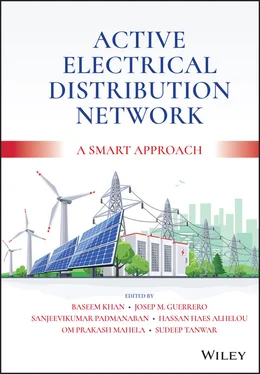Active Electrical Distribution Network
Здесь есть возможность читать онлайн «Active Electrical Distribution Network» — ознакомительный отрывок электронной книги совершенно бесплатно, а после прочтения отрывка купить полную версию. В некоторых случаях можно слушать аудио, скачать через торрент в формате fb2 и присутствует краткое содержание. Жанр: unrecognised, на английском языке. Описание произведения, (предисловие) а так же отзывы посетителей доступны на портале библиотеки ЛибКат.
- Название:Active Electrical Distribution Network
- Автор:
- Жанр:
- Год:неизвестен
- ISBN:нет данных
- Рейтинг книги:5 / 5. Голосов: 1
-
Избранное:Добавить в избранное
- Отзывы:
-
Ваша оценка:
- 100
- 1
- 2
- 3
- 4
- 5
Active Electrical Distribution Network: краткое содержание, описание и аннотация
Предлагаем к чтению аннотацию, описание, краткое содержание или предисловие (зависит от того, что написал сам автор книги «Active Electrical Distribution Network»). Если вы не нашли необходимую информацию о книге — напишите в комментариях, мы постараемся отыскать её.
Discover the major issues, solutions, techniques, and applications of active electrical distribution networks with this edited resource Active Electrical Distribution Network: A Smart Approach
Active Electrical Distribution Network: A Smart Approach
Active Electrical Distribution Network — читать онлайн ознакомительный отрывок
Ниже представлен текст книги, разбитый по страницам. Система сохранения места последней прочитанной страницы, позволяет с удобством читать онлайн бесплатно книгу «Active Electrical Distribution Network», без необходимости каждый раз заново искать на чём Вы остановились. Поставьте закладку, и сможете в любой момент перейти на страницу, на которой закончили чтение.
Интервал:
Закладка:
22 Chapter 22Figure 22.1 Development of a meter system.Figure 22.2 Architecture of a traditional meter and SM.Figure 22.3 Blocks of MDMS.Figure 22.4 Transmission architecture.
List of Tables
1 Chapter 1 Table 1.1 Various forms of DF model.
2 Chapter 2 Table 2.1 Voltage difference across all open...
3 Chapter 4 Table 4.1 Harmonics analysis under balanced loads. Table 4.2 Harmonics analysis under load unbalancing.
4 Chapter 5 Table 5.1 Simulation parameter specifications Table 5.2 EV charger simulation operating states
5 Chapter 6Table 6.1 Traditional grid and smart grid comparison.Table 6.2 IEE 802 Standards.Table 6.3 List of classification standards.
6 Chapter 7Table 7.1 The differences between the control units of...Table 7.2 The classification of decision support functions.
7 Chapter 8Table 8.1 Capacitor banks and their impacts on bus voltages.Table 8.2 Economic analysis.Table 8.3 Voltage profiles of different buses under...
8 Chapter 9Table 9.1 Various applications of ESSs in the distribution network.
9 Chapter 10Table 10.1 Conventional state estimation results of voltage...Table 10.2 Conventional state estimation results of voltage...Table 10.3 Mean square error comparison for state estimation...Table 10.4 21-bus Southern region conventional state estimation...Table 10.5 21-bus Southern region conventional state estimation...Table 10.6 Mean square error comparison for the state estimation...
10 Chapter 11Table 11.1 Difference between a conventional and an...Table 11.2 Stakeholders of a smart grid.
11 Chapter 13Table 13.1 International comparison of wind power capacity.
12 Chapter 14Table 14.1 SRRA Stations established in India.Table 14.2 Solar-PV measuring instruments.Table 14.3 Meteorological measuring instruments.Table 14.4 General instruments.Table 14.5 Meteo data for Jodhpur, India.
13 Chapter 15Table 15.1 PVDG parameters
14 Chapter 16Table 16.1 Comparison between different energy storing...Table 16.2 Charging and discharging energy lossesTable 16.3 Principal discrepancies and relationships between...
15 Chapter 17Table 17.1 Line characteristics of System 1Table 17.2 Load data for System 1Table 17.3 Line characteristics of System 2Table 17.4 Load data for System 2Table 17.5 Line characteristics of System 3Table 17.6 Load data for System 3Table 17.7 Line characteristics of System 4Table 17.8 Transformer data for System 4Table 17.9 Load data for System 4Table 17.10 Line characteristics of System 5Table 17.11 Load data for System 5Table 17.12 Line characteristics of System 6Table 17.13 Load data for system 6Table 17.14 Load data for System 7Table 17.15 Line characteristics of System 7Table 17.16 Line characteristics of System 8Table 17.17 Load data for System 8Table 17.18 Line characteristics of System 9Table 17.19 Load data for System 9Table 17.20 Line characteristics of System 10Table 17.21 Load data for System 10Table 17.22 Line characteristics of System 11Table 17.23 Load data for System 11Table 17.24 Line characteristics of System 12Table 17.25 Load data for System 12Table 17.26 Line characteristics of System 13Table 17.27 Load data for System 13Table 17.28 Line characteristics of System 14Table 17.29 Load data for System 14Table 17.30 Line characteristics of System 15Table 17.31 Load data for System 15
16 Chapter 18Table 18.1 Numerical results for Case 1Table 18.2 Numerical results for Case 2Table 18.3 Numerical results of proposed models for Case 3Table 18.4 Ranking of models based on loss reduction for Case 3Table 18.5 Ranking of models regarding voltage improvement for Case 3Table 18.6 Ranking of models based on execution time for Case 3Table 18.7 Numerical results for Case 4Table 18.8 Numerical results for Case 5Table 18.9 Numerical results of proposed models for Case 6Table 18.10 Models based on computational time in Case 6Table 18.11 Models according to voltage enhancement in Case 6Table 18.12 Arrangement of models according to loss reduction for Case 6Table 18.13 Numerical results for Case 7Table 18.14 Numerical results for Case 8Table 18.15 Numerical results for Case 9Table 18.16 Ranking of models based on loss reduction for Case 9Table 18.17 Ranking of models regarding voltage improvement for Case 9Table 18.18 Ranking of models based on execution time for Case 9Table 18.19 Numerical results for Case 10Table 18.20 Ranking of models based on loss reduction for Case 10Table 18.21 Ranking of models regarding voltage improvement for Case 10Table 18.22 Ranking of models based on execution time for Case 10Table 18.23 Numerical results of proposed models for Case 11Table 18.24 List of models regarding loss minimization in Case 11Table 18.25 Models based on nodal voltage enhancement of Case 11Table 18.26 Classification of models according to running time in Case 11Table 18.27 Numerical results for Case 12Table 18.28 Ranking of models based on loss reduction for Case 12Table 18.29 Ranking of models regarding voltage improvement for Case 12Table 18.30 Ranking of models based on execution time for Case 12Table 18.31 Numerical results of proposed models for Case 13Table 18.32 Arrangement of the results based on power loss....Table 18.33 Computation times for Case 13Table 18.34 Numerical results compared to other methods for Case 14
17 Chapter 19Table 19.1 Numerical results for Example 1.Table 19.2 Ranking of methods based on execution time for Example 1.Table 19.3 Numerical results for Example 2.Table 19.4 Ranking of methods based on execution time for Example 2.Table 19.5 Numerical results for Example 3.Table 19.6 Ranking of methods based on loss reduction for Example 3.Table 19.7 Ranking of methods regarding voltage improvement for Example 3.Table 19.8 Ranking of methods based on execution time for Example 3.Table 19.9 Numerical results for Example 4.Table 19.10 Ranking of methods based on computing time for Example 4.Table 19.11 Numerical results for Example 5.Table 19.12 Ranking of methods based on loss reduction for Example 5.Table 19.13 Ranking of methods regarding voltage improvement for Example 5.Table 19.14 Ranking of methods based on execution time for Example 5.Table 19.15 Numerical results for Example 6.Table 19.16 Arrangement of methods according to loss reduction for Example 6.Table 19.17 Methods based on computational time in Example 6.Table 19.18 Methods according to voltage enhancement in Example 6.Table 19.19 Numerical results compared to other methods for Example 7.Table 19.20 Ranking of methods based on loss reduction for Example 7.Table 19.21 Ranking of methods regarding voltage improvement for Example 7.Table 19.22 Ranking of methods based on execution time for Example 7.Table 19.23 Numerical results compared to other methods for Example 8.Table 19.24 Ranking of methods based on loss reduction for Example 8.Table 19.25 Ranking of methods regarding voltage improvement for Example 8.Table 19.26 Ranking of methods based on execution time for Example 8.Table 19.27 Numerical results compared to other methods for example 9.Table 19.28 Ranking of methods based on loss reduction for Example 9.Table 19.29 Ranking of methods based on execution time for Example 9.Table 19.30 Ranking of methods regarding voltage improvement for Example 9.Table 19.31 Numerical results compared to other methods for Example 10.Table 19.32 Ranking of methods based on loss reduction for Example 10.Table 19.33 Ranking of methods regarding voltage improvement for Example 10.Table 19.34 Ranking of methods based on execution time for Example 10.Table 19.35 Numerical results of proposed model compared...Table 19.36 List of methods regarding loss minimization in Example 11.Table 19.37 Methods based on nodal voltage enhancement of Example 11.Table 19.38 Classification of solution methods according to...Table 19.39 Numerical results compared to other methods for Example 12.Table 19.40 Ranking of methods based on loss reduction for Example 12.Table 19.41 Ranking of methods regarding voltage improvement for Example 12.Table 19.42 Ranking of methods based on execution time for Example 12.Table 19.43 Numerical results of proposed model compared to other methods...Table 19.44 Arrangement of the results based on power loss reduction in Example 13.Table 19.45 Computation times for Example 13.Table 19.46 Numerical results compared to other methods for Example 14.Table 19.47 Ranking of methods based on loss reduction for Example 14.Table 19.48 Ranking of methods regarding voltage improvement for Example 14.Table 19.49 Ranking of methods based on execution time for Example 14.Table 19.50 Numerical results compared to other methods for Example 15.Table 19.51 Ranking of methods based on loss reduction for Example 15.Table 19.52 Ranking of methods regarding voltage improvement for Example 15.Table 19.53 Ranking of methods based on execution time for Example 15.
Читать дальшеИнтервал:
Закладка:
Похожие книги на «Active Electrical Distribution Network»
Представляем Вашему вниманию похожие книги на «Active Electrical Distribution Network» списком для выбора. Мы отобрали схожую по названию и смыслу литературу в надежде предоставить читателям больше вариантов отыскать новые, интересные, ещё непрочитанные произведения.
Обсуждение, отзывы о книге «Active Electrical Distribution Network» и просто собственные мнения читателей. Оставьте ваши комментарии, напишите, что Вы думаете о произведении, его смысле или главных героях. Укажите что конкретно понравилось, а что нет, и почему Вы так считаете.











